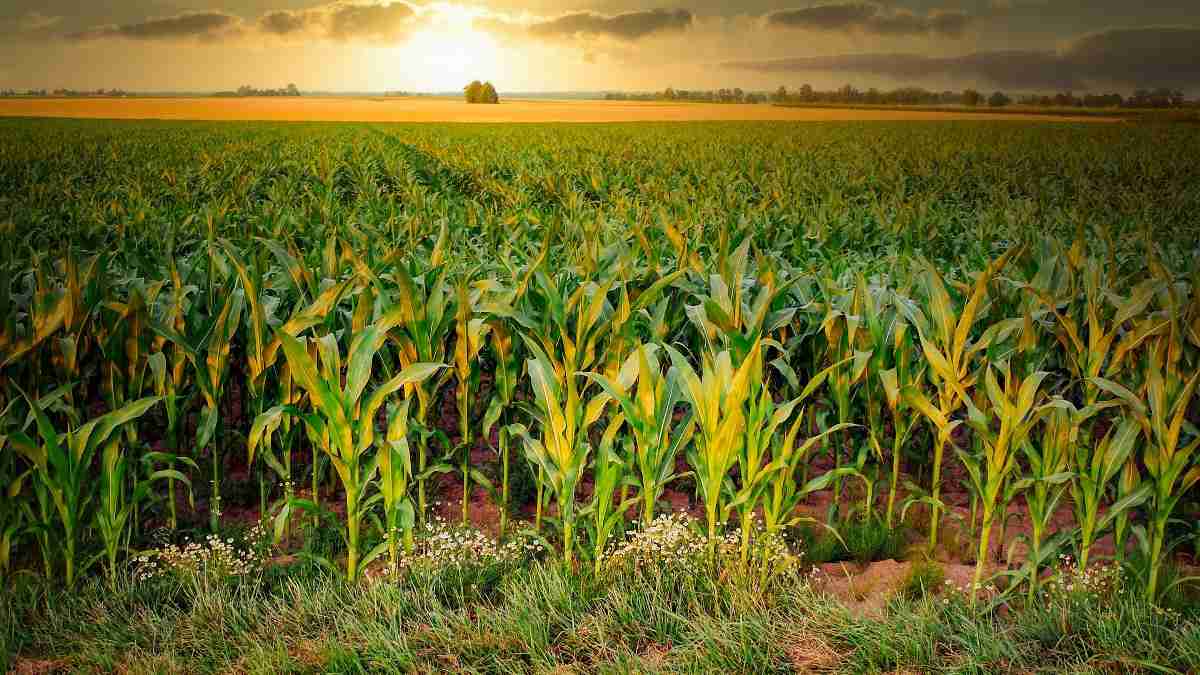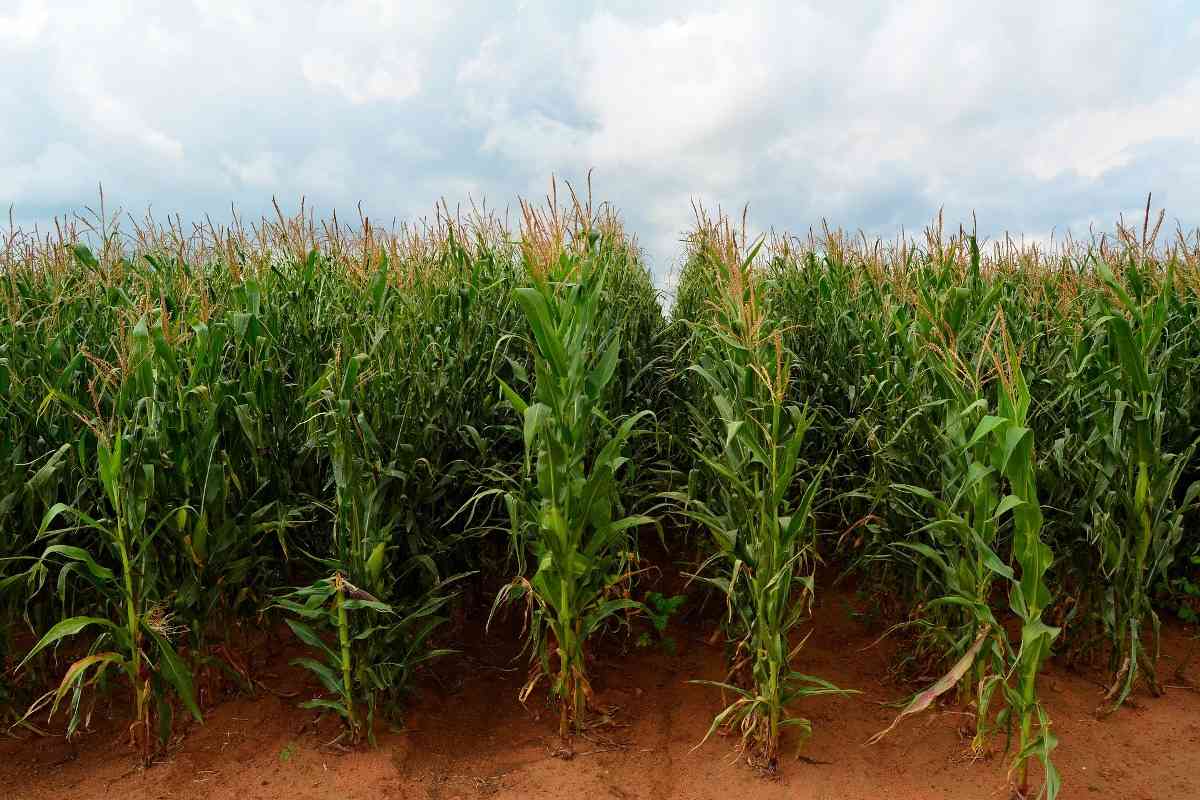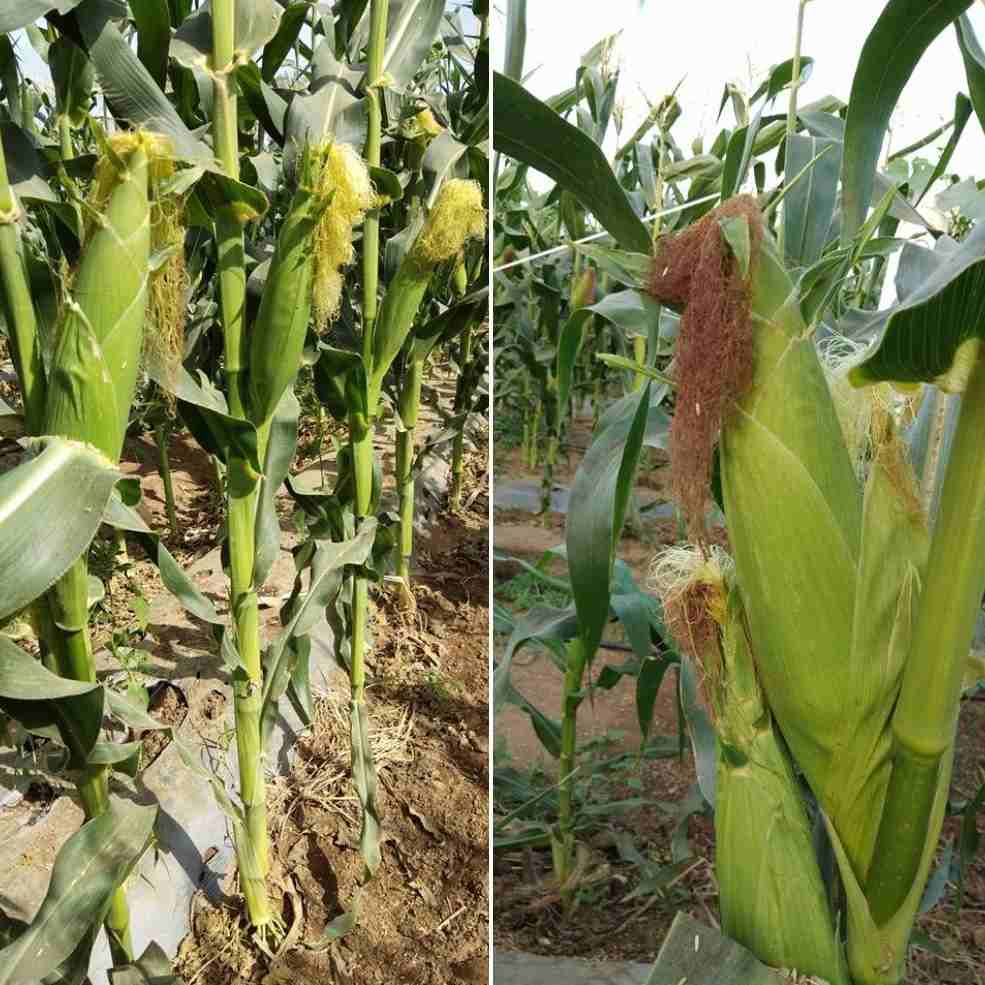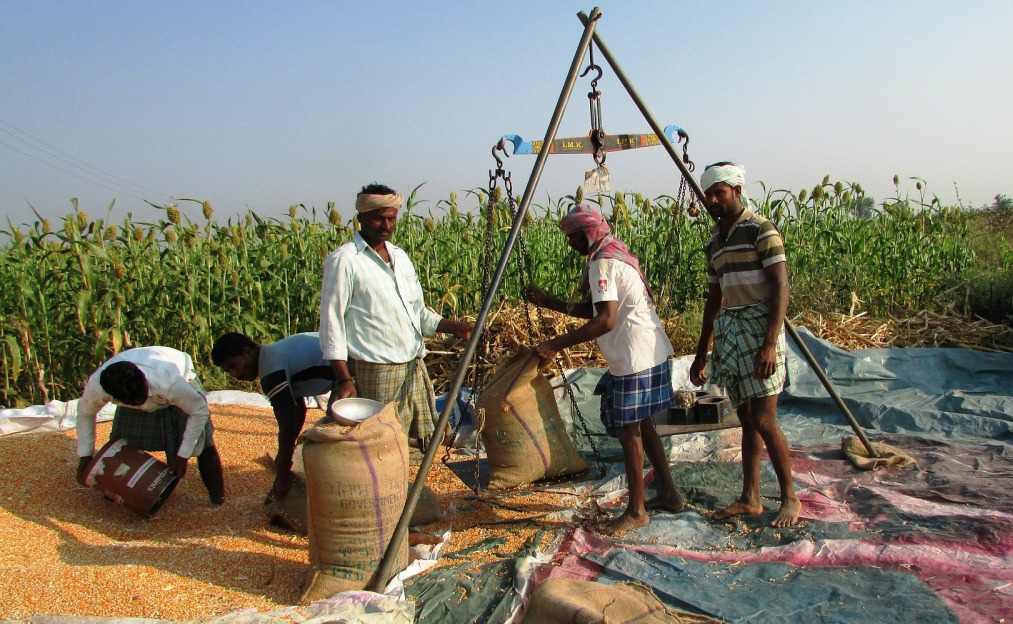Introduction to organic maize farming (corn)
Organic maize is a vitamin C, magnesium-rich food, and provides a good amount of daily dietary fiber. It is a good source of Antioxidants and maize kernels are a good source of carotenoid antioxidants, which are known to support the immune system. Organic farmers manage insects, weeds, and other pests with mechanical cultivation and cultural, biological control and biorational controls. Biorational control methods aim to manage the pest species with the minimum amount of disturbance to beneficial insects.
A step by step guide to organic maize farming and cultivation practices
Organic farmers do not use conventional commercial fertilizers, synthetic pesticides, and synthetic growth regulators. Organic farmers do not use genetic engineering, and as defined in the excluded methods of the National Organic Program. An organic farm requires less capital investment than a conventional farm, as it does not require the purchase of chemical fertilizers. Many farmers take out large loans to get started, but organic farmers don’t rely on chemicals and this means taking less of a blow if the crop yield is low in a particular year.
Depending on the conditions, organic farming may yield less than conventional methods. Though, the premiums are high with organic farming as most organic produce is sold for 20-30% more than conventional produce. So with less start-up debt and higher crop profits, an organic farm can be more successful in a short amount of time. It is a holistic production management system that promotes and enhances the health of agro-ecosystem related to bio-diversity, nutrient bio-cycle, and soil biological and microbial activities. It is a form of agriculture that relies on methods such as crop rotation, green manure, compost, and biological pest control.

Organic maize can be marketed on a farmer to farmer basis or sold to elevators or feed mills specializing in organic grain. Organic maize prices can range from 1.5 to 2 times the price of conventional maize. Organic maize production has some challenges that are maintaining a diverse crop rotation, developing a balanced, sustainable, low-cost fertility plan and mastering the art of mechanical weed control, but based on some of the farmers, you should be able to produce maize that yields about 80% to 100% of conventional production. Organic maize gets a bit harder to manage as you move to larger acreages, and this makes it more difficult to deal with the rotation, fertility, and mechanical weed control issues. Organic maize production comes at a higher initial economic cost; this is more than offset by the higher prices three times as much that people are willing to pay for organic crops. The higher prices these crops can fetch compared to conventional crops, combined with the rise of organic meat and dairy production that means there is a high potential for expansion and profit.
The organic production system is designed to;
- Enhance biological diversity within the whole system;
- Increase soil biological activity;
- Maintain long-term soil fertility;
- Recycle wastes of plant and animal origin to return nutrients to the soil, so minimizing the use of non-renewable resources;
- Promote the healthy use of soil, water, and air with minimize all forms of pollution that may result from agricultural practices;
- Promote the careful processing methods agricultural products to keep the organic integrity and vital qualities of the product at all stages;
- Become established on any existing farm through a period of conversion, the suitable length of which is determined by site-specific factors such as the history of the land, and type of crops and livestock to be produced.
Site preparation and soil fertility management for organic maize farming
Maize is a warm-season vegetable that needs full sun, ample water, and deep, rich garden soil to perform well. Warmer temperatures at night also accelerate growth. Then, prepare the planting site by working in generous amounts of quality organic compost or well-aged animal manure. Plants need to be well protected from frost.
Cover the planting area with black plastic for two to four weeks before planting to warm the soil and improve germination. Maize will not germinate if soil temperatures are below 12°C.
Soil fertility management is critical. The cost-effective approaches are to rely on N from a legume, cover crop and manure sources, and P and K from manure. While organic fertilizers are available, they are generally more expensive than their conventional counterparts. Consider the long-term effects of your system: relying solely on poultry manure for N in maize production, for example, will result in excessive P levels. Selling organic silage maize or hay could deplete K levels rapidly and increase the need for organic fertilizer. Maize grows best in soil with a pH level between 5.8 and 6.5.
Maize seed rate and seed treatment
The optimum seeding rate of maize ranged from 28,000 to 40,000 seeds per acre with an average economic optimum seeding rate of 34,000 seeds per acre.
Organic seed treatment of Maize
The purpose of seed treatment is to improve seed performance in one or more of the following ways;
1) Eradicate seed-borne pathogens or protect from soil-borne pathogens,
2) Optimize ease of handling and accuracy of planting, and
3) Improve germination rates.
An organic liquid biological seed treatment applied as a seed film coating and formulated with beneficial microbes, macronutrients and micronutrients, amino acids, organic acids, enzymes, proteins, vitamins, and minerals. All maize crops benefit from the application of seed treatment, protecting the seed and emerging seedlings during the establishment period against economically damaging insect pests and diseases. Maize seed treatment plays a big part in ensuring germinating seedlings survive and develop through the first 6 weeks after planting, to the point where external influences are less likely to adversely affect growth and final crop yield. The primed seed has absorbed just enough water to dissolve germination inhibitors and activate the early stages of seed germination.
A seed health treatment is a broad category of treatments that includes hot water, biological and plant extracts, bleach disinfection, and biologicals (microbes). These treatments can develop seed and seedling health by eradicating seed-borne pathogens from the seed or protecting germinating seeds from attack by soil-borne pathogens.
Maize seed spacing or plant distance
Plant Maize seeds 3 – 5cm deep with 8cm between seeds in rows 45 – 60cm apart. Thin to 20 – 30cm spacing’s when plants are 10 – 15cm tall. Though, increase seeding rates to ensure a good stand if soils are cold.
Maize seed germination
Maize is a warm-season crop. While it can survive at a minimum of about 10°C, it is recommended that you wait until there are consistent warm temperatures in your region. Preferred soil temperature for maize seed germination ranges from 16°C-35°C. With this in mind, it’s important and ensures that you are not planting too early.
Organic products for fertilizing maize in organic farming
Conventional systems that have used synthetic fertilizers and pesticides cannot become certified as “organic systems” in a single year. Several years are needed to transition away from these chemicals. During the transition period, competitive crops should be grown and managed to reduce the weed seed bank in the soil. Once organic certification is achieved, these crops can be used in rotation to aid in weed management. Successful organic systems generally rely on multiyear, soil fertility, and pest (insect, disease, and weed) management plans. Crop rotations that minimize bridging of diseases and insects from one year to the next also help the main crop remain healthy and better able to withstand other abiotic and biotic stresses.
If you want to avoid using chemical-based fertilizers in your veggie patch, you’ll need to turn to organic nitrogen fertilizers to give your maize plants a boost. The following sources of nitrogen are plant- or animal-based and require soil microbes to break them down into a form of nitrogen the plants can use. Thankfully, upon adding one of these fertilizers to the maize patch, all the necessary soil microbes work very quickly to break down these products and release the nitrogen to your growing maize plants.
The cultivars were raised with a similar dose of organic manures such as cattle dung manure, vermicompost, and poultry manure (1:1:1) meeting a total of 100 kg N ha-1 applied before sowing. The maize cultivars were grown under the rainfed condition with a standard package of the practice of organic farming.
A combination of organic manures has improved the nitrogen use efficiency, micro, and macronutrient recovery and help in P solubilization and its uptake by the plants and enhanced K availability that in turn resulted in better plant growth and yield of maize.
Alfalfa meal – Alfalfa can be grown for 2 to 3 years to help minimize weeds. When planting alfalfa, choose a variety that regrows quickly and use a companion crop such as oats to help control weeds during alfalfa establishment. Made from dried alfalfa plants, this plant-based fertilizer is about 4 percent nitrogen. It’s often used as an animal feed supplement, too, and it promotes a balance of healthy soil microbes.
Cottonseed meal – A coarsely granulated product made from the hulls of cottonseeds, cottonseed meal is about 6 percent nitrogen. Once in the soil, it rapidly breaks down and provides a burst of nitrogen to plants within a few days of application.
Blood meal – Derived from dried blood from slaughterhouses, blood meal contains about 12 percent nitrogen. It acts quickly in the soil and begins to provide nitrogen to plants almost immediately.
Feather meal – Feather meal contains approximately 14 percent nitrogen. It’s inexpensive, though it takes a bit longer for the microbes to mineralize than some of the other organic nitrogen sources discussed here.
Soybean meal – With a nitrogen content of about 7 percent, soybean meal is another option for fertilizing maize in the home garden.
Fish fertilizers – Liquid fish fertilizers as well as granular fish-based fertilizers are good nitrogen sources for the maize patch. Though they can smell bad, fish-based fertilizers are mineralized by soil microbes very rapidly. Depending on the formulation, they can contain between 5 percent and 10 percent nitrogen.
Organic maize farming process
In case if you miss this: Problems Faced By Indian Farmers.

Many types of cultivation implements are available and can be used once or many times during the season. Cultivation provides a clean seedbed and can be used to give immediate control of weeds between the rows. Two or three cultivations are typical for organic maize grain systems. Timing for all cultivation operations is critical, and it can take several years to establish optimal timing for weed control in your fields. Though, complacency and performing the same operation at the same time every year will result in a spread of species other than those that were originally problematic. Rotary hoeing and harrowing can be used if the maize and weeds are not too large (that is, weeds at the white-thread stage). Rotary hoeing on a diagonal, rather than up and down the rows, at 10 to 12 mph is purported to provide the greatest weed control. There are challenges with a cultivation that should be considered before adoption. In rolling landscapes, erosion possibilities may outweigh the benefits of tillage and must be assessed because permanent damage can occur to soils with one untimely operation. Soil health may be reduced by untimely operations causing crusting, reduced water infiltration, and reduced organic matter and residues in surface soils.
Principles of organic maize agriculture practices
The organic agriculture practices are based on the principles;
Principle of ecology – Organic agriculture must be based on living ecological systems and cycles, work with them, emulate them, and help to sustain them. Organic management should be adapted to local conditions, ecology, culture, and scale. The reduction of inputs by reuse, recycle and the efficient management of materials and energy will contribute to developing environmental quality and will conserve resources.
Principle of health – It avoids the use of fertilizers, pesticides, animal drugs, and food additives that may have adverse health effects.
Principle of fairness – This principle emphasizes that those involved in organic agriculture must conduct human relationships in a manner that ensures fairness at all levels and to all parties – farmers, workers, processors, distributors, traders, and consumers. It insists that animals should be provided with the conditions and opportunities of life according to their physiology, natural behavior, and well-being. Natural and environmental resources that are used for production and consumption should be managed in a socially and ecologically fairway and must be held in trust for future generations.
Principle of Care -This principle states that precaution and responsibility are the key concerns in management, development, and technology choices in organic farming. Though, it must consider valid solutions from practical experiences, accumulated traditional and indigenous knowledge and prevent significant risks by adopting appropriate technologies and rejecting unpredictable ones, such as genetic engineering
Management of insect pests in organic maize farming
You may also check this: Organic Okra Farming.

Organically approved sprays of maize
There are some chemical herbicides approved for use in organic production, though, the efficacy of these applications are inconsistent. Though, sprays approved for application for weed control in organic systems with or without approved organic surfactants included clove, cinnamon, and garlic oils; citric acid; and ammonium nonanoate. As with any pesticide application, always read label directions.
Organic production of field maize must rely upon three strategies for insect management;
- Keeping pest populations below threshold levels.
- Making the crop unattractive as possible to invading pests.
- Keeping the crop optimally competitive and tolerant of insects as possible.
Management of maize seed and seedling feeding insects uses tactics that impact one or more of the above-mentioned areas. Cultural practices are important in establishing a vigorous, full stand of seedlings. Producing a vigorous and competitive crop requires planning and site preparation.
Pest and disease management options in maize organic farming
The pest and disease management options in organic farming are heavily dependent on preventive measures rather than curative practices are based on ecologically safer management.
Insect pests can be a major problem in maize production. While maize may be attacked by a wide number of insects, we will here focus on those that are considered a major problem in most areas of the country. These include European maize borer, maize rootworm, and cutworms. A few of the technologies that will be discussed are too expensive for use with standard field maize but may be economical for the production of high-value specialty maize.
Control of Maize crop insects with tillage;
Seed and small seeding-feeding insect pests are found in the soil or at the soil surface. Wireworms, cutworms, grubs, seed maize beetle, and other pests are mainly affected by winter or early spring disking, the accompanying bird feeding, and exposure. Residue on the soil surface protects pests. Damage to maize seed and small seedlings is greater in no-tillage or minimum tillage versus conventional tillage. Normally, early spring disking destroys this cover, brings many pests to the surface, and attracts large numbers of seagulls, grackles, cowbirds, blackbirds, and other species. The combined action of these factors kills and disrupts populations of potential pests and can give meaningful protection to planted maize seed and small seedlings. Organic maize production, no-tillage culture must be avoided, especially in areas where southern maize billbug, wireworms, and black cutworm are commonly occurring pests.
Maize harvesting
Maize is ready for harvesting when the stalks and leaves are somewhat green but the husk cover has dried and turned brown. Shell Maize when the moisture content ranges from 15 to 20%.

Maize is predominantly harvested mechanically, while exceptions do occur in the case of hand harvesting.
Hand harvesting of maize
The entire plant can be cut and placed into stacks while still green color. Once it is dry, the ears can be picked and threshed, and the entire plant with the ear can be utilized as maize hay. Otherwise, the plants can be left in the field to dry and the ears harvested. Conventional harvest or combines could be used for threshing Maize with husk to save labor involved in dehusking. The Maize ears should preferably be dried for 3 to 4 days after harvesting to improve grain recoveries and reduce breakage losses during the shelling.
You may be interested in this: How to Make Money from Organic Farming Business.
So interested on organic farming in Elgeiyo Marakwet. I have gained a lot in your articles.
Nice guide lines received as I am doing as per article here.
I’ve enjoyed the article, and I’ve decided to be ready this tomorrow